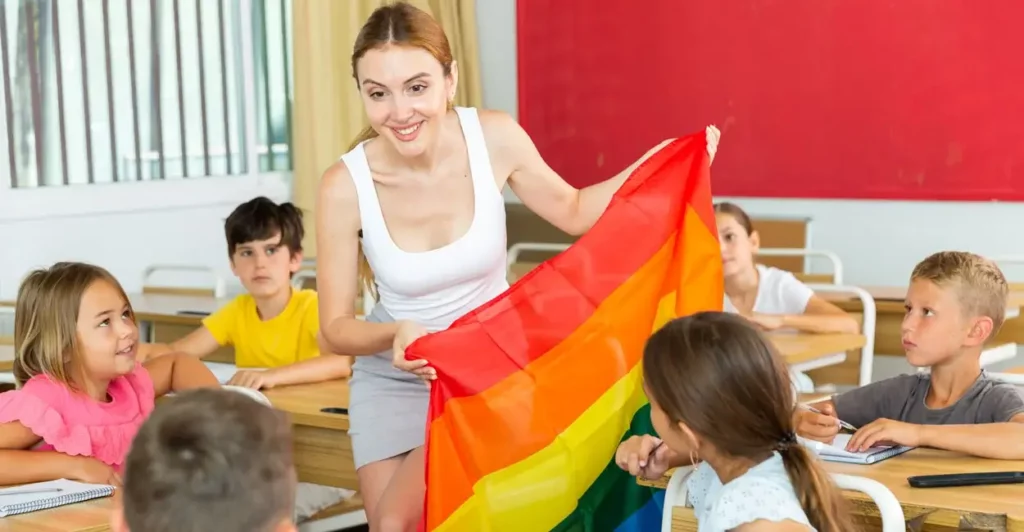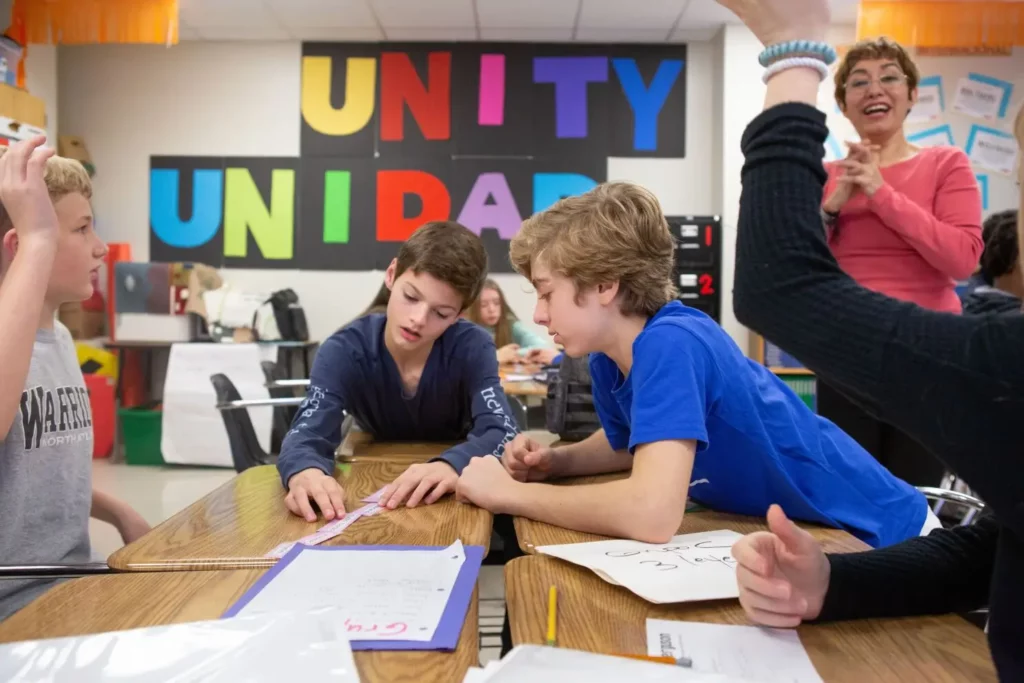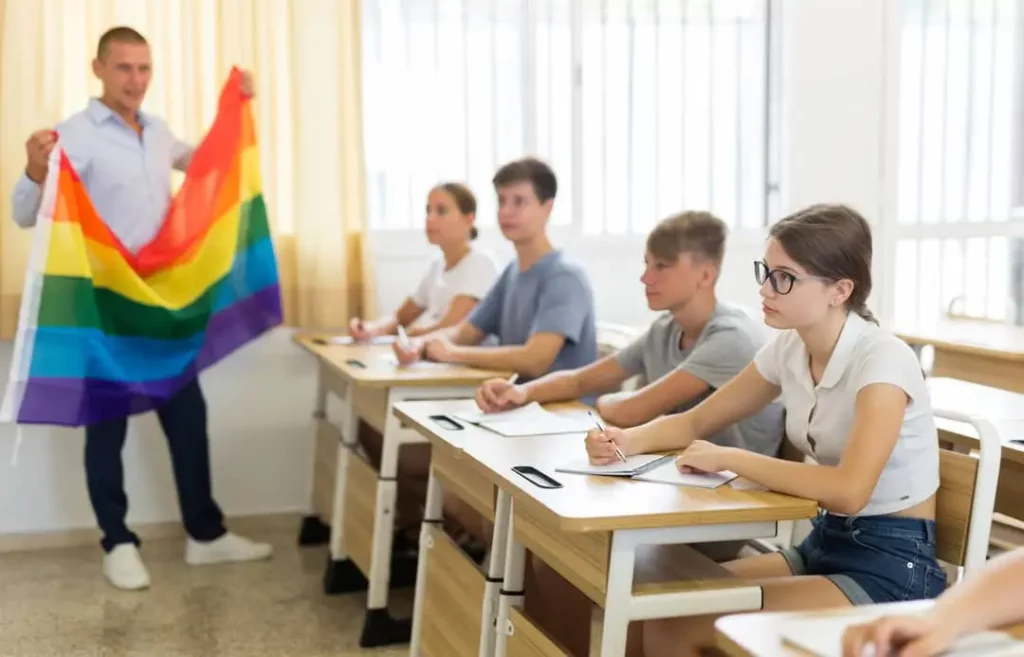The classroom is more than a place for academic growth—it’s a miniaturized version of society. But for many students who identify as Lesbian, Gay, Bisexual, Transgender, Queer, or Questioning (LGBTQ+), school can be a challenging, and at times, hostile environment. As we strive to foster a culture of understanding and respect in our schools, one critical aspect we need to address is LGBTQ+ education.
In this blog post, we will delve into the profound role of LGBTQ+ education in creating such safe spaces. We will explore why it is indispensable, how schools can embody these principles and the challenges they may face. So let’s get started!
Contents
What is LGBTQ+ Education?
 LGBTQ+ education is a comprehensive approach to learning that includes acknowledging, understanding, and accepting the diverse spectrum of sexual orientations and gender identities. It’s about ensuring that LGBTQ+ students and their experiences are represented in school curriculums, policies, and practices, while also fostering a culture of respect and acceptance among all students.
LGBTQ+ education is a comprehensive approach to learning that includes acknowledging, understanding, and accepting the diverse spectrum of sexual orientations and gender identities. It’s about ensuring that LGBTQ+ students and their experiences are represented in school curriculums, policies, and practices, while also fostering a culture of respect and acceptance among all students.
In practice, LGBTQ+ education encompasses several key aspects. First, it involves teaching about LGBTQ+ history, contributions, and issues within society.
Secondly, LGBTQ+ education includes teaching about different sexual orientations and gender identities in an age-appropriate and respectful manner. This is done with the intent to broaden understanding and promote empathy among students.
Finally, LGBTQ+ education is about addressing homophobia, biphobia, and transphobia in schools. It involves creating policies and practices that protect LGBTQ+ students from harassment and discrimination, while also teaching students how to challenge stereotypes, biases, and misconceptions.
The Importance of LGBTQ+ Education

LGBTQ+ education plays a pivotal role in shaping inclusive and safe school environments. Here’s why it is so essential:
- Promotes Inclusivity and Acceptance: Incorporating LGBTQ+ education in the curriculum fosters a more inclusive and accepting environment. It enables students to understand and respect differences, helping to create a school culture that values all individuals, irrespective of their sexual orientation or gender identity.
- Reduces Bullying and Harassment: Studies indicate that LGBTQ+ students often face bullying and harassment at school. Through education, students learn about the harmful effects of bullying, helping to reduce incidences of harassment and fostering a more empathetic student body.
- Supports Mental Health: LGBTQ+ students are more likely to experience mental health issues due to feelings of isolation, discrimination, or lack of understanding. LGBTQ+ education can help alleviate these concerns by creating an environment of acceptance and understanding.
- Encourages Self-expression and Identity Exploration: By discussing different sexual orientations and gender identities, LGBTQ+ education provides a safe space for students to explore their own identities and express themselves openly.
- Increases Awareness and Understanding: Educating students about LGBTQ+ issues helps to challenge stereotypes and misconceptions, leading to greater understanding and empathy among the student body.
- Creates Equality in Education: LGBTQ+ education ensures that all students have access to the same quality of education, free from discrimination or bias. This makes for a fairer, more equitable school environment.
- Prepares Students for a Diverse Society: The world is diverse, and it’s important that students are prepared to engage respectfully with all kinds of people. LGBTQ+ education prepares students for this reality, helping them become responsible, compassionate members of society.
Statistics To Underscore The Importance
To underscore the importance of LGBTQ+ education, let’s delve into some sobering statistics that highlight the current scenario and its implications on students’ mental and physical health:
- LGBTQ+ Youth and Mental Health: In 2021, 42% of LGBTQ+ youth seriously considered attempting suicide, including more than half of transgender and nonbinary youth. Furthermore, LGBTQ+ youth with low levels of in-school LGBTQ+ inclusion were almost twice as likely to have attempted suicide compared to those in highly inclusive schools.
- Discrimination and Harassment: A 2019 survey found that nearly 60% of LGBTQ+ students felt unsafe at school because of their sexual orientation, and more than 35% were unable to participate in school functions due to a hostile school climate.
- Lack of Representation: The same survey found that only 19.2% of students were taught positive representations about LGBTQ+ people, history, or events in their schools. This lack of representation can leave LGBTQ+ students feeling unseen and unsupported.
- Absence from School: The survey also indicated that over a third of LGBTQ+ students missed at least one day of school in the past month due to feeling unsafe or uncomfortable, impacting their academic achievement.
- Bullying and Violence: According to a 2021 study, approximately 33% of LGBTQ+ students were bullied on school property, and 27.1% experienced cyberbullying.
- Effects of Supportive Environments: On the other hand, the same report indicated that school-based strategies such as anti-bullying policies, and supportive school staff significantly decreased the likelihood of suicide attempts among LGBTQ+ students.
These statistics illuminate the harsh realities many LGBTQ+ students face daily. It is clear that without comprehensive LGBTQ+ education and support structures in schools, these students are at risk of mental health issues, academic decline, and even life-threatening situations.
The Role of Schools in Creating Safe Spaces

Schools play a crucial role in fostering safe and inclusive environments for all students, including those in the LGBTQ+ community. Here are the primary ways schools can contribute to creating such spaces:
Implementing Inclusive Curriculum
Schools should ensure that the curriculum is inclusive of LGBTQ+ experiences. This includes teaching about important LGBTQ+ figures and events in history, as well as incorporating literature and other materials that reflect the experiences of LGBTQ+ individuals. This not only helps LGBTQ+ students feel seen and validated but also promotes empathy and understanding among all students.
Providing Resources
Schools can provide resources such as literature, counseling, and support groups specifically designed for LGBTQ+ students. Having access to these resources can help students feel more supported and less isolated.
Creating Supportive Policies
Schools should enact policies that specifically protect LGBTQ+ students from bullying and discrimination. This includes anti-bullying policies as well as guidelines to ensure that students are able to express their gender identity safely (for example, allowing students to use bathrooms that correspond to their gender identity).
Promoting a Supportive Environment
The atmosphere of a school significantly impacts a student’s well-being. Teachers, staff, and administrators should strive to create an environment that celebrates diversity and promotes acceptance. This includes being open to discussions about LGBTQ+ issues and addressing any incidences of homophobia or transphobia promptly and effectively.
Offering Staff Training
Training for teachers and other staff members is crucial for fostering an inclusive environment. Such training can help staff understand how to address LGBTQ+ issues appropriately and how to support LGBTQ+ students effectively.
Involving the Community
Schools can work with parents, local organizations, and the broader community to promote understanding and acceptance of LGBTQ+ individuals. This might involve organizing events, workshops, or discussions that encourage community-wide participation.
By undertaking these measures, schools can go a long way in creating spaces where all students, regardless of their sexual orientation or gender identity, feel safe, respected, and empowered to learn.
Challenges in Implementing LGBTQ+ Education & Their Solutions
Despite the significant benefits, implementing LGBTQ+ education does come with its own set of challenges. Let’s examine these obstacles and some potential solutions:
Challenge 1: Societal and Cultural Resistance: Many communities, parents, or educators may resist LGBTQ+ education due to cultural beliefs, personal biases, or misunderstandings about the LGBTQ+ community.
Solution: Implementing outreach programs that educate parents and community members about the importance of LGBTQ+ education can help dispel myths and promote understanding. Creating open dialogue, through workshops or meetings, can help address concerns and resistance.
Challenge 2: Lack of Knowledge or Training: Teachers may lack the necessary knowledge or training to teach about LGBTQ+ issues effectively or to handle related incidents, such as bullying.
Solution: Providing teachers with professional development opportunities on LGBTQ+ topics can equip them with the necessary understanding and skills. Resources, training programs, and support from organizations specializing in LGBTQ+ issues can be invaluable here.
Challenge 3: Limited Resources: Schools may lack the necessary resources, such as inclusive curriculum materials or counseling services, to support LGBTQ+ students.
Solution: Schools can seek help from LGBTQ+ organizations, many of which offer free or inexpensive resources. Collaborating with these organizations can provide valuable guidance and materials to support inclusive education.
Challenge 4: Policy Restrictions: Some jurisdictions may have policies or laws in place that prevent or restrict the teaching of LGBTQ+ topics.
Solution: Advocacy at the local, state, or national level is necessary to challenge and change such policies. Engaging with parent-teacher associations, school boards, and lawmakers can be instrumental in advocating for policy changes.
While these challenges can be significant, they are not insurmountable. With commitment, collaboration, and advocacy, schools can overcome these obstacles and create a supportive, inclusive environment for all students.
Conclusion
The journey towards a truly inclusive educational landscape, where every student is recognized, understood, and celebrated, is a collective effort. As we look towards a future that embraces diversity in all its forms, we cannot overlook the importance of LGBTQ+ education.
Yes, there are challenges to implementing LGBTQ+ education, from societal resistance to policy restrictions, but these hurdles don’t lessen the necessity of this education. Instead, they highlight the need for robust advocacy, community education, and committed collaboration between schools, parents, and the community.
Life may sometimes be challenging for people from the LGBTQ community, but Online LGBTQ Counseling can help. Get experienced LGBTQ therapists at PrideMantra: Book a trial LGBTQ therapy session


